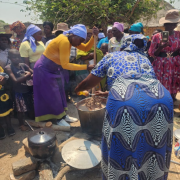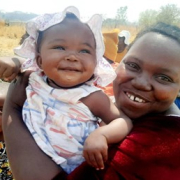District Food and Nutrition Security Committees (DFNSCs) form the nucleus for tackling food and nutrition security in a coordinated and holistic manner, with specific core functions. They lead the coordination of food and nutrition security activities at the sub-national level by providing a platform for interaction among relevant Government ministry representatives, development partners, academia and civil society. In this collaborative framework all stakeholders are accountable for ensuring that their sectors meaningfully engage and contribute to improving food and nutrition security at all their levels of operation within the identified national priorities.
Mashonaland East – The Kuwirirana Care Group, Mutoko District has become a vital initiative in the battle against child malnutrition, significantly contributing to food and nutrition security for the community. This grassroots effort mobilises local resources and empowers families to ensure that their children receive the essential nutrients needed for healthy development. By addressing the nutritional needs of young children, the group is fostering a healthier future for the entire village.

Kuwirirana Caregroup Members Preparing Maoresa Porridge in Ward 1- Janha Village, Mutoko District
Background
The Kuwirirana Care Group was established as part of a broader initiative to combat malnutrition in the district. This community-led model brings together families, health workers and local leaders to create a supportive network focused on improving nutritional outcomes. So far the initiative has trained 12 Lead Mothers and 3 Community Based Health Workers, equipping them with the knowledge and skills necessary to implement effective feeding programmes and mobilise resources. Since its inception, the programme has expanded to engage 38 villages in the area, fostering a collaborative approach to nutrition and health. The programme is fully supervised by the Ward Food and Nutrition Security Committee (WFNSC) who pay visits to the clusters, monitoring the cooking and feeding. The local Environmental Health Technician and Nutrition Assistant on the other hand give technical support.
Key Initiatives
The Kuwirirana Care Group focuses on training Lead Mothers and Community Based Health Workers to mobilise resources for feeding schemes aimed at children under five. Key initiatives include:
- Cooking Demonstrations: Monthly cooking demonstrations feature nutrient-rich Maoresa porridge, designed to provide essential vitamins and minerals to combat malnutrition. These sessions have expanded to involve men in the community, encouraging them to participate in meal preparation and nutrition education.
- Community Engagement: Lead Mothers recruit mothers and guardians into ‘Neighbour Groups’ of 10 or more, fostering community support and resource sharing. The programme has also actively involved men by encouraging them to support their partners in childcare and nutrition efforts, thereby promoting a more inclusive approach.
- Screening for Malnutrition: Regular screenings are conducted by Community Based Health Workers to monitor the health of children and ensure timely intervention when needed. Men in the community have been engaged in these screenings, helping to raise awareness about the importance of nutrition and health among families.
Impact and Outcomes
The impact of the Kuwirirana Care Group has been profound:
- Improved Nutritional Status: The feeding programme has resulted in noticeable improvements in the nutritional status of participating children. Parents have reported increased energy levels and better overall health among their children.
- Community Awareness: The initiative has raised awareness about nutrition and health issues within the community. Families are now more knowledgeable about balanced diets and the importance of nutrient-rich foods.
- Increased Participation: The involvement of men in nutrition education and meal preparation has fostered a sense of shared responsibility in childcare. This shift has not only strengthened family bonds but has also encouraged men to take an active role in supporting their partners and children.
- Sustainability Efforts: The active participation of traditional leaders, including Chief Charewa, has helped in mobilising resources and sustaining community interest in the initiative. Their involvement ensures that the programme is integrated into local governance and development plans.

Chief Charewa, Janha Village, Ward 1, Mutoko District – Chief Charewa highlighted that the care group model programme has helped the community’s efforts in combating child malnutrition.
Conclusion
The Kuwirirana Care Group exemplifies the transformative power of community-driven initiatives in enhancing food and nutrition security. By prioritising the nutritional needs of children and actively involving men in the process, this group is not only addressing immediate health challenges but also laying the groundwork for a healthy community.




